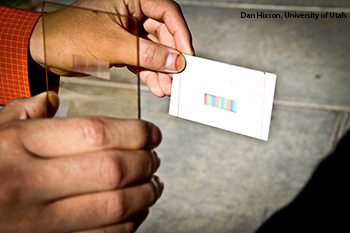
Peng Wang and Rajesh Menon designed a thin transparent film that boosts solar cell efficiency by up to 50 percent.

A polychromat film integrated into the cover glass of a solar panel.
Sunlight could be an endless source of clean energy if we could devise more practical ways to collect it. Researchers at the University of Utah, U.S.A., have created an affordable thin film that increases the efficiency of regular solar cells by sorting and concentrating sunlight, allowing the cell to absorb more light and therefore produce more energy. The film, called a polychromat, could boost solar cell performance by up to 50 percent.
Electrical engineers Rajesh Menon and Peng Wang and colleagues created a multi-bandgap high-efficiency photovoltaic based on a transparent polychromat overlay (Prog. Photovoltaics, DOI: 10.1002/pip.2516). When placed over a photovoltaic device, the film splits sunlight into an arbitrary number of smaller bands. In a dual-bandgap configuration, the polychromat separates sunlight into high-energy and low-energy light. The two bands of light are directed to GaAs and GaInP absorbers designed to capture wavelengths specific to each band. The band-specific absorbers in the film allow the cell to extract more energy from light than conventional solar cells that only absorb a narrow range of wavelengths. The team achieved the best results—a 50 percent increase in efficiency—from a computer simulation with an eight-bandgap polychromat film.
The films measure 50 mm by 10 mm with 3-µm-wide grooves for sorting incoming sunlight. The dual-bandgap prototype was made using photolithography, but Menon states that future versions of polychromats can be made with a low-cost stamping process similar to the method used to make DVDs. In addition to solar panels, the polychromat film has potential uses in boosting LED displays in mobile phones and improving colors in low-light photography.
